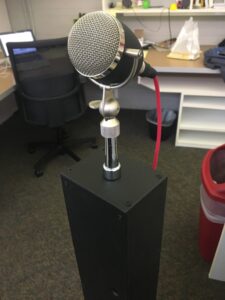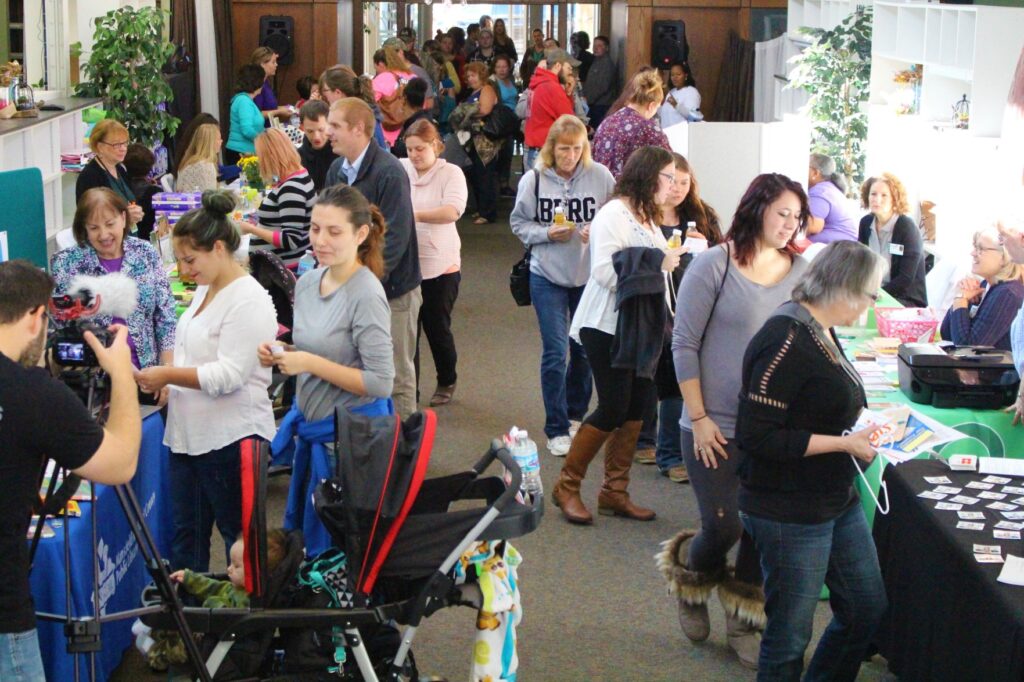Editor’s note: This is part of a collection of essays on how to reach new audiences by listening. We asked four journalists from across the country to explain approaches they’ve used to build trust with specific communities, particularly those who may be alienated or disengaged. Writing from Ohio, Brittany Schock describes how Richland Source organized a special event that followed reporting on a difficult topic, and listened more deeply in the process.
The topic of infant mortality isn’t easy to broach among most people. In fact, a close friend told me she had avoided reading about the topic because it “scares the bejeezus out of me.”
It’s not an unreasonable fear. Between 2005 and 2015, there were 14,877 babies born in my adopted hometown of Richland County, Ohio; 108 of those babies died. That equals an infant mortality rate of 7.3 deaths per 1,000 live births. It’s an issue seemingly impossible to tackle in the healthcare field due to its complexity, and terrifying to think about as a parent.
So we decided to take that uncomfortable energy and channel it into something that will help the community, as opposed to simply informing readers that a problem exists.
Instead of focusing on the tragedy of losing a child, we wanted to focus on the happy, positive experiences of being pregnant and welcoming a new baby into the world. A baby shower was the best way to do that.
As a journalist covering the infant mortality epidemic in my community, I knew approaching a mother about the scary parts of being pregnant and raising children was going to take a delicate touch. In fact, I decided not to approach them at all.
To create this opportunity, I organized an event — the Richland Source Community Baby Shower — to connect young families with myriad community resources and to educate and support healthy pregnancies and babies.
From 10 a.m. to 2 p.m. on Saturday, Sept. 9, 2017, our office at Richland Source saw approximately 500 people come through. It was going to be nearly impossible to engage with every single person in a meaningful way.
At the Baby Shower event, I set up a Listening Post, a journalistic tool that allows newsrooms to make meaningful connections within their community without the pressure of face-to-face interviews. A standalone microphone and a question will get you a long way.
Ask experienced mothers their best advice for new parents, and the answers are pretty predictable: Sleep. Ask for help when you need it. If your kid will eat nothing but hot dogs, then let them eat hot dogs.
But ask expecting mothers what they are most nervous about, or what they are most looking forward to, and the answers can be surprisingly poignant: Nervous about failing. Nervous about accidentally hurting their child. Nervous about giving birth.
“I’m most nervous about being good enough, but I’m looking forward to meeting her and being the best mom that I can be,” was the response from a young teenage mother expecting her first baby on Christmas Day.
It was a vulnerable idea to share. And it was exactly the kind of answer I was hoping for.
Creating and using the Listening Post
I first learned about the concept of the Listening Post at a Solutions Journalism summit in April 2017, where I presented my written series on infant mortality in Richland County. It was there I met Burgess Brown, community manager at the Listening Post Collective, and I knew immediately I wanted to find a way to incorporate the idea of freestanding journalism into a future project.
Instead of bringing journalism to each person, we decided to let them come to the journalism. That’s where the Listening Post came in.
The large volume of people we saw come through the Community Baby Shower combined with a sensitive topic like infant mortality was the perfect recipe for a Listening Post. It gave mothers the opportunity to speak only if they wanted to, and the Post was very low-maintenance for the journalists involved.
We partnered with the Renaissance Theatre in Mansfield to build our Listening Post, which amounted to a wooden post with a microphone on top and a recording device inside. At the Post, we asked mothers one of two questions: If you are an expectant mother, what’s one thing you are most nervous about and one thing you’re looking forward to? Or as an experienced mother, what advice would you give to brand-new mothers?
I will admit, the maiden voyage of the Listening Post did not go as smoothly as I had hoped. Most of the challenges, however, were logistical and amount to lessons we have for next time — for example, it is imperative to have a recording device inside that is simple to use: the recording device provided to us by the Renaissance Theatre required multiple presses of the “record” button for it to work. Asking your users to press the button once, then once the red light is flashing to press it again, then once the red light is solid speak your piece, then press it once again to turn off proved far too complicated.
The Post also needed to stay plugged in at all times or else the creator of the Post would have to take it apart to reprogram the device. Of course, within five minutes of the Listening Post launch someone accidentally tripped over the power cord and unplugged the device. One panicked phone call and 45 minutes later, it was up and running again, but it was certainly a design flaw that should be worked out before future uses.
Other “notes for next time” include mindfulness about how to present questions. At first, I had created a sign presenting the two questions when mothers entered the Listening Post space, and expected them to remember their question by the time they got up to the Post. That was a mistake, and we quickly converted to making slips of paper mothers could carry with them and refer to as they spoke.
In addition to these challenges, we decided to make our lives difficult and take portraits of each mother to pair with a multimedia project I knew I eventually wanted to make.
Because there were so many variables to our Listening Post project, that left a lot of room for human error. But convincing mothers to use the Listening Post turned out to be easy when we offered a special door prize, and we had around 100 mothers’ names in our prize drawing.
The results
At the end of the day, I did not have 100 audio and portraits to choose from. Our logistical bumps meant only around 63 mothers figured out how to use it and produce usable audio clips — 30 were new mothers, and 33 were experienced mothers. Of those 63 mothers, only 39 had taken usable portraits. I learned all this after devoting an entire workday to parsing through the material and putting my project together.
I know what you’re thinking — almost 40 mothers is still a lot to work with. It certainly is, and I couldn’t even include everyone in my project. But a large sample size was necessary when accounting for audio or portrait errors.

And the audio/portrait pairs that did come to fruition were better than I could’ve expected.
Speaking their fears and hopes about parenthood requires a level of vulnerability I was nervous to ask of our Post users, but they really delivered. I wagered that people would be more apt to open up if they were speaking only into a microphone, instead of interacting with another person. I also designed the Listening Post space to allow for a bit of privacy.
One mother opened up about her experience with postpartum depression, and how the love for her child was something that grew over time instead of something she experienced right away. A few expectant mothers shared their nervousness over raising their children to be good human beings. One new mother shared her hope of raising her child differently than her parents raised her.
The combined anecdotes made for a much more powerful multimedia project that stirred emotions among those who viewed it. The video was viewed nearly 5,000 times on our Facebook page alone, and it gave us real insight for any other projects about motherhood we might pursue.
It also got me thinking: what else could I ask of my community with a Listening Post? Could I put it in a local coffee shop and ask for suggestions of future stories? Could I put it in the town square and ask passersby if their families have ever been affected by opioid abuse? The possibilities are endless.
The effects of engaging with local mothers has also rippled throughout the community. Of a total 14 vendors who responded to a survey sent by Richland Source, 50 percent said that compared to similar events, the Community Baby Shower was “the best ever,” and 92 percent of vendor respondents said they were able to make meaningful connections with potential clients.
As for the mothers, one respondent to the survey told us, “From one new mom to another this is something all new moms should experience. I am so very thankful for that baby shower. Please keep it going. The help and information was a blessing! THANK YOU!”
I firmly believe the community baby shower was a success because we as a news organization worked as a collaborator and congregator in the community. Don’t be afraid to be a part of the solution. Host the meetings if you need to. Start those conversations. Be a source of education and a lighthouse for information. And listen along the way.
Brittany Schock can be reached by email at brittany@richlandsource.com.
Share with your network
Focused Listening
You also might be interested in:
The Houston Chronicle created small-scale experiments that tested how strategically work with a creator while navigating potentially thorny issues around ethics, control and impact. In this series, they walk you through what they did.
Every community has a commons — a park, a library, a garden — a shared space that only thrives when people care for it together. Our local information ecosystems are no different. At our recent Local News Summit, we asked the room: What does it mean to be gardeners, guards and stewards of the local information commons?
We know psychological safety might feel like a ‘nice to have,’ but what if the failure to create that safety is silently stalling your best ideas and alienating your next generation of leaders?




